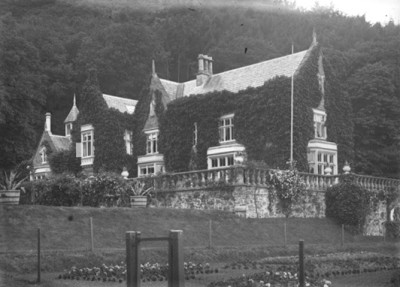|
what
is good for Devon must also be good for Somerset |
see
documentary by Rhys Davies

the Lynton stage about to leave from Minehead
station
Communication along the north coast from Lynton
to Minehead was very poor at this time, and the terrible hill at Porlock was
looked upon with fear by many travellers. In 1898 an alternative was proposed
in the form of a Minehead & Lynton Light Railway; a two foot gauge tourist
line which would have started alongside the GWR station at Minehead and
followed the coast through Porlock and Countisbury, terminating near the Tors
Hotel at Lynmouth. The line was fully surveyed and a public enquiry held by
the Light Railway Commissioners in Minehead, but there was insufficient
public support and Sir George Newnes of the Lynton and Barnstaple Railway
opposed the scheme claiming that there was adequate transport already
available for the region.

Porlock Hill
So things would have
remained, were it not for the Halliday family.
The Hallidays vied with Sir George Newnes for the position of 'great local
landowner'. Their residence, the Glenthorne Estate, was founded by the
Reverend Walter Halliday, a nouveau riche Scottish intellectual who inherited
his money from his father Simon, a banker who had amassed a small fortune
during the Napoleonic wars. Simon’s Will directed Walter to use part of it to
establish a family estate, and accordingly Glenthorne House was built between
1839 and 1846.

Glenthorne House
Walter Halliday,
aspiring social status, gradually purchased Countisbury parish, the
title of Lord of the Manor to go with it and set about 'bringing
modernity' to the local population in the manner of a ‘benevolent
despot’, providing employment on his estate and establishing Poor
Houses for the destitute of the area.
His nephew, Mr William H. Halliday, inherited the estate in 1872.
William was to later become a director of the Lynton and Barnstaple
Railway and played a core role throughout its inception and
construction. He died on May 11th 1898 on the very day that the first
train steamed into Lynton.
The estate was inherited by his son, William Benjamin Halliday (or 'Ben
Halliday'), who realised that unless the Glenthorne Estate developed
new business opportunities, it could be lost to the family within a few
decades.

William Benjamin Halliday
Historically, coal from
South Wales had been landed on Glenthorne Beach
and sold to local merchants, and Halliday decided that this business could be
further developed if he constructed a deep water harbour close by. This site
was the only place along this part of the coastline where deeper
draught ships could approach the shore. He also
began to construct a small power station near Porlock. While Porlock Weir
afforded access to shallow draught vessels expansion of that small harbour was
not feasible. A narrow gauge
railway was to be built to ship the coal from the harbour to the power
station.

The newly built West Porlock power station
However, Halliday found himself running up against Sir George Newnes, who was
against further development of the area and owned enough of the intervening
land between Glenthorne and Porlock to prevent him from building his railway.
This forced Halliday into applying for an Act of Parliament which would give
him powers of compulsory purchase. In order to succeed, he would have to
reroute the railway inland to join up as many villages as possible. This, he
believed would bring him overwhelming public support with which to defeat any
opposition rallied by Newnes. This decision marked the beginning of a long
feud between the families.
The plan was to build a line connecting with the Lynton and Barnstaple to
Minehead, with a branch line to the harbour and another to the Porlock power
station. The proposal would have allowed relatively easy grades down to
Minehead which would be approached from the East via Dunster and the Avill
Valley.
The Minehead Railway Extension bill was presented to Parliament in 1899. This
was passed by the Commons but rejected by the Lords. Sir George Newnes had
managed to get support from the local elite to oppose the bill. The cited
grounds for rejection included lack of proper stations for Barbrook and
Lynton, and Newnes also managed to convince the owners of Oare Manor that the
railway would deface their views and devalue their property.
click here to see large scale maps
of original proposal
A modified bill was presented
in the following year. The changes included a stiff grade down to Barbrook
and Lynton and the provision of stations there. Consequently, a huge viaduct
would have to be built near Lynton to return the line back to its intended
route. The line was also diverted in the vicinity of Malmsmead through a deep
cutting behind Oare Manor, with a private halt promised for the manor. This
deviation meant that much more extensive civil engineering works would be
needed and grades on the climb to the summit would be much steeper.
The cost of the undertaking had now risen dramatically, as Newnes had hoped,
in the belief that this would force Halliday to give up. Newnes was unaware,
however, of funds available to Halliday from Scotland. The issue
of the new railway had now become a matter of pride to Halliday and the
line would be built no matter what the cost. The bill
received Royal Assent on April 6th 1900 as the Minehead Extension Railway
Act, authorising the Minehead-Lynton main-line.

One week later, two light railway orders were awarded to the newly formed
Glenthorne Harbour Authority, granting powers to build the steeply graded
branch line to the port (Glenthorne Railway No.1) and a second branch from Wootton Courtenay to Porlock
West (Glenthorne Railway No.2).
With the required powers in hand,
construction of the new railway could begin.

|